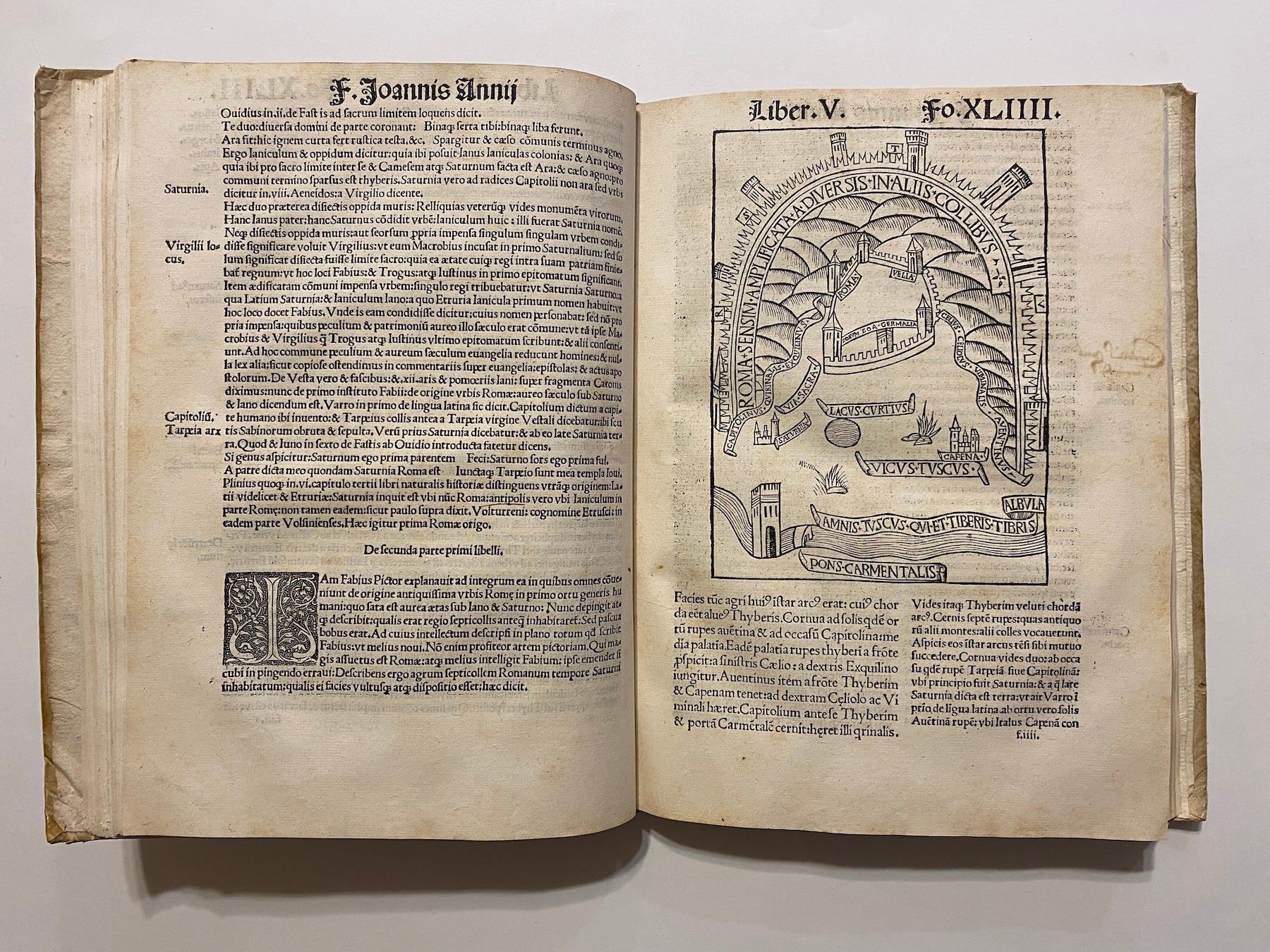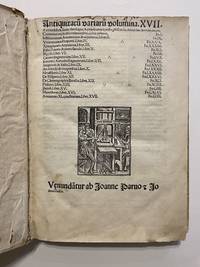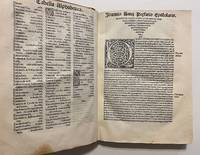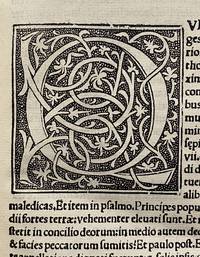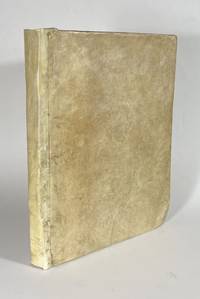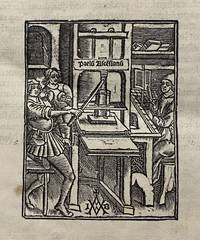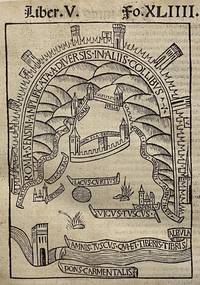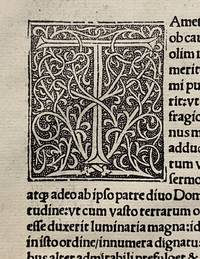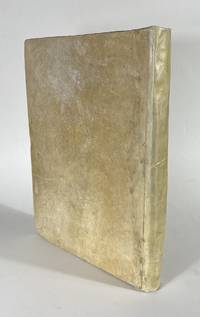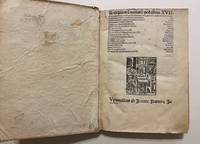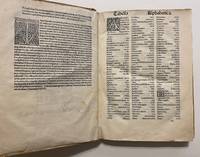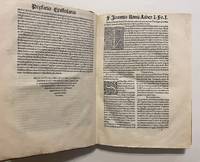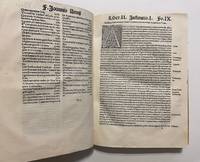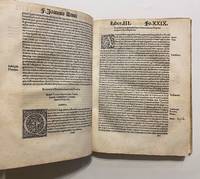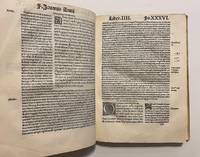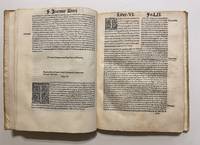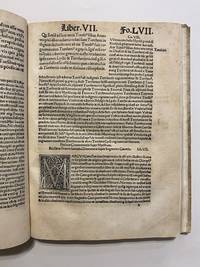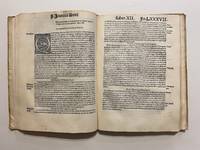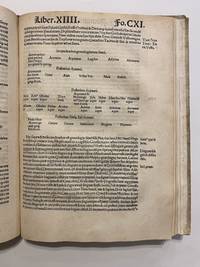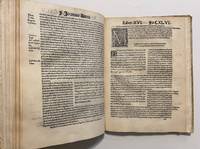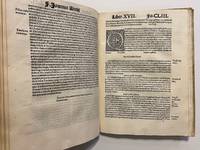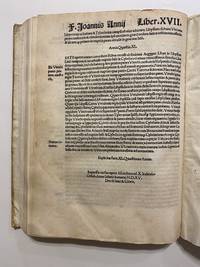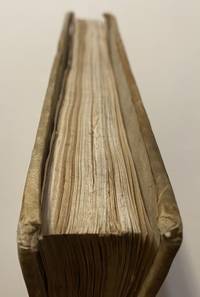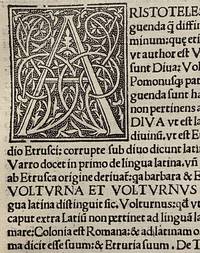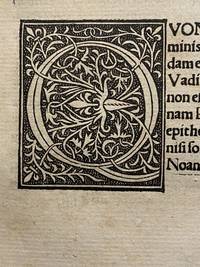[POST-INCUNABLE ~ 1515: RENAISSANCE LITERARY FORGERY]. Antiquitatum variarum volumina XVII
- SIGNED
- Paris: Joannes Parvus & Jodocus Badius (Jean Parvo and Josse Bade), 1515
Paris: Joannes Parvus & Jodocus Badius (Jean Parvo and Josse Bade), 1515. Good. Folio (textblock: 265 x 190 mm; binding: 275 x 210 mm). [6], 171 ff. (including final blank), COMPLETE. Badius's printer's device on title-page, one woodcut "map" of Rome (see below). NB: two types of paper stocks can be clearly discerned, one of which is a little foxed. Old vellum over stiff boards, later spine (corners bumped, evidence of two bookplates removed from inside front board; binder's blank at the back but not at the front, presumably extracted; early inscription on title-page cropped too close for legibility; 3-line ink stain on fol. c8). Withal a good, complete copy. MOST PREFERRED EARLY EDITION OF ONE OF THE MOST FAMOUS COLLECTION OF LITERARY FORGERIES OF ALL TIME, PRESENTED AS ANCIENT WORKS "REDISCOVERED" BY A DOMINICAN PRIEST WHO IS TODAY DESCRIBED AS "THE PRINCE OF FORGERS." THE ENTIRE CHARADE HAS NO HISTORICAL PRECEDENCE AND IN ITS WAY HAS NEVER BEEN SURPASSED. WHILE THESE OUTLANDISH FABRICATIONS NOW SEEM CARNIVALESQUE, THEY WERE ACCEPTED AS GENUINE FOR DECADES AFTER THE AUTHOR'S DEATH.
Offered here is an outrageous anthology of "very ancient chronicles" that are accompanied by the author's lengthy and even more outrageous "learned commentary" which we are told took "a lifetime of research." This author was none other than Giovanni Nanni (1432-1502) who was in his day very well respected as a scholar who claimed to read Oriental, Semetic, and Etruscan languages. In fact, he was a complete charlatan. Among the his forged texts are those "written by" Berosus the Chaldean, Manetho the Egyptian, Metasthenes the Persian, and others. Our author included a woodcut map of Rome (fol. XLIIII) which is actually a loose interpretation of one of his own faked documents. All good things must come to an end, and Nanni's forgeries finally began to unravel by the mid-16th century and were ultimately demolished (most effectively by Joseph Scaliger). For every reason this is a marvellous book.
"Of all the forgeries, detected or undetected, in the Italian world of letters, none is more famous than that associated with the name of Annius [who] contributed more to the confusion of literature, whether innocently or not, than any man of his own or of any other generation. The work consisted of seventeen distinct treatises, of which eleven were by different writers, who had been 'lost' to the world until their 'discovery' by Annius. The texts of these authors he interspersed with the most prolix commentaries of his own, these constituting by far the larger part of his voluminous work. And if genuine the authors themselves were well deserving of comment, for they would have thrown light on some of the remotest and darkest periods of history. Priceless would they have been, had their authenticity only been above suspicion. It was probably the inconceivability of any man writing so immense a work for a mere pastime or even for the propagation of his own ideas that led so many learned men at the time to believe in Annius." (SOURCE: J.A. Farrer, Literary Forgeries, Chapter IV: "Italian Forgery - Annius of Viterbo," passim).
Nanni claimed that these texts ("written by priests on the basis of documents in public archives") refuted the "lying" World Histories by Herodotus and Diodorus. Nanni then wove an artificial web which connected the Bible and Egypt to Greece and Rome; he also fabricated a genealogical web which connected antiquity to modernity. Other impudences include "proof" that the final resting place of Noah's ark was at the Gianicolo in Rome and that Noah was actually the Roman god Janus. Additionally, Nanni re-created a whole genealogy of giants (!) in order to justify the noble ancestry of the French nobility of the period (see fol. CXII, "Araxa Prisca"); he also provided genealogical "proof" that the Popes descended from Moses himself.
First published in 1498, the present 1515 edition was reprinted from that published by Parvus and Badius in 1512, here with CORRECTIONS. Paoli (p. 89) states that these two are "the most well-known editions of the 'Antiquities,' as they comprise all the Annian sources and his commentaries. They are in fact commonly used and quoted by modern researchers as Josse Badius inserted proper foliation, a rich index, useful marginal notes, and all the paratexts which had been missing in the 'editio princeps.'"
RARITY: Ours appears to be the earliest copy of the collection currently on the market.
COMMENT: Another of Nanni's notorius schemes transpired 1493 whereby he orchestrated a well-publicized "archeological excavation" in Viterbo. There in the ruins he single-handedly "discovered" and dramatically unearthed certain marble statues; are we not surprised that he had personally buried said artifacts in advance?
§ Adams A-1166. Renouard, Ascensius II, 36. The fullest account of Nanni's fake texts and inscriptions is given in "Fake? The Art of Deception" (ed. Mark Jones, Paul Craddock, and Nicolas Barker), no. 42. Carol Rose, "Giants, Monsters, and Dragons: An Encylopedia of Folklore, Legend, and Myth" p. 299. Roberto Weiss, "Traccia per una biografia di Annius of Viterbo" in: Italian Studies Presented to E.R. Vincent, 1962. See also Lorenzo Paoli, "Re-Forging a Forgery: The French Editions of Annius of Viterbo’s Antiquitates" in: Faking It! The Performance of Forgery in Late Medieval and Early Modern Culture (2022) pp. 75-118.
Offered here is an outrageous anthology of "very ancient chronicles" that are accompanied by the author's lengthy and even more outrageous "learned commentary" which we are told took "a lifetime of research." This author was none other than Giovanni Nanni (1432-1502) who was in his day very well respected as a scholar who claimed to read Oriental, Semetic, and Etruscan languages. In fact, he was a complete charlatan. Among the his forged texts are those "written by" Berosus the Chaldean, Manetho the Egyptian, Metasthenes the Persian, and others. Our author included a woodcut map of Rome (fol. XLIIII) which is actually a loose interpretation of one of his own faked documents. All good things must come to an end, and Nanni's forgeries finally began to unravel by the mid-16th century and were ultimately demolished (most effectively by Joseph Scaliger). For every reason this is a marvellous book.
"Of all the forgeries, detected or undetected, in the Italian world of letters, none is more famous than that associated with the name of Annius [who] contributed more to the confusion of literature, whether innocently or not, than any man of his own or of any other generation. The work consisted of seventeen distinct treatises, of which eleven were by different writers, who had been 'lost' to the world until their 'discovery' by Annius. The texts of these authors he interspersed with the most prolix commentaries of his own, these constituting by far the larger part of his voluminous work. And if genuine the authors themselves were well deserving of comment, for they would have thrown light on some of the remotest and darkest periods of history. Priceless would they have been, had their authenticity only been above suspicion. It was probably the inconceivability of any man writing so immense a work for a mere pastime or even for the propagation of his own ideas that led so many learned men at the time to believe in Annius." (SOURCE: J.A. Farrer, Literary Forgeries, Chapter IV: "Italian Forgery - Annius of Viterbo," passim).
Nanni claimed that these texts ("written by priests on the basis of documents in public archives") refuted the "lying" World Histories by Herodotus and Diodorus. Nanni then wove an artificial web which connected the Bible and Egypt to Greece and Rome; he also fabricated a genealogical web which connected antiquity to modernity. Other impudences include "proof" that the final resting place of Noah's ark was at the Gianicolo in Rome and that Noah was actually the Roman god Janus. Additionally, Nanni re-created a whole genealogy of giants (!) in order to justify the noble ancestry of the French nobility of the period (see fol. CXII, "Araxa Prisca"); he also provided genealogical "proof" that the Popes descended from Moses himself.
First published in 1498, the present 1515 edition was reprinted from that published by Parvus and Badius in 1512, here with CORRECTIONS. Paoli (p. 89) states that these two are "the most well-known editions of the 'Antiquities,' as they comprise all the Annian sources and his commentaries. They are in fact commonly used and quoted by modern researchers as Josse Badius inserted proper foliation, a rich index, useful marginal notes, and all the paratexts which had been missing in the 'editio princeps.'"
RARITY: Ours appears to be the earliest copy of the collection currently on the market.
COMMENT: Another of Nanni's notorius schemes transpired 1493 whereby he orchestrated a well-publicized "archeological excavation" in Viterbo. There in the ruins he single-handedly "discovered" and dramatically unearthed certain marble statues; are we not surprised that he had personally buried said artifacts in advance?
§ Adams A-1166. Renouard, Ascensius II, 36. The fullest account of Nanni's fake texts and inscriptions is given in "Fake? The Art of Deception" (ed. Mark Jones, Paul Craddock, and Nicolas Barker), no. 42. Carol Rose, "Giants, Monsters, and Dragons: An Encylopedia of Folklore, Legend, and Myth" p. 299. Roberto Weiss, "Traccia per una biografia di Annius of Viterbo" in: Italian Studies Presented to E.R. Vincent, 1962. See also Lorenzo Paoli, "Re-Forging a Forgery: The French Editions of Annius of Viterbo’s Antiquitates" in: Faking It! The Performance of Forgery in Late Medieval and Early Modern Culture (2022) pp. 75-118.


